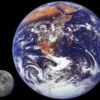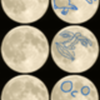The moon, if you could see it through the clouds, is full at the moment. Here are some interesting facts about the moon stolen from various web sources:
According to the leading theory the Moon was created when a rock the size of Mars slammed into Earth, shortly after the solar system began forming about 4.5 billion years ago. Compared to other planets, the Moon is massive compared to the earth-- (about 2159 miles from edge to edge (about a third less that the coast-to-coast distance of the US – see image below). As a result, some consider the earth/moon system a double planet.
The total surface area of the moon is about the same as the surface areas of Africa.
The Moon is in synchronous rotation about the Earth. In fact, most major moons in the solar system have synchronous rotation due to tidal locking. In astronomy, synchronous rotation is where the orbiting body takes as long to rotate on its axis as it does to make one orbit. As a result the moon always keeps the same hemisphere pointed at towards earth.
Many people presume that the dark side of the moon is always dark and the sunlit side is always sunlit. This is not true. The sun rises and sets on all parts of the moon just as on earth. The difference is that while the earth rotates every 24 hours, the moon rotates once every 29.5 days.
Even the cheapest pair of binoculars revel a pockmarked planet that has been tortured by meteors for billions of years. The earth (and every other rocky planet in the solar system) would look exactly like the moon if it conditions on earth were the same as the moon. We see craters on the moon because e Moon is not geologically very active, so earthquakes, volcanoes and mountain-building don't destroy the landscape as they do on Earth; and with virtually no atmosphere there is no wind or rain, so very little surface erosion occurs. So, every reader of the post is sitting squarely in the middle of an ancient crater that has been erased by erosion.
The Moon is not round (or spherical). Instead, it's shaped like an egg. If you go outside and look up, one of the small ends is pointing right at you.
As you read this, the Moon is moving away from us. Each year, the Moon steals some of Earth's rotational energy, and uses it to propel itself about 3.8 centimeters higher in its orbit. Researchers say that when it formed, the Moon was about 14,000 miles (22,530 kilometers) from Earth. It's now more than 280,000 miles, or 450,000 kilometers away.
The Man in the Moon is an example of pareidolia). Other cultures perceive the silhouette of a woman, a hare/rabbit, a frog, a moose, a buffalo, or a dragon (with its head and mouth to the right and body and wings to the left) in the full moon. Alternatively, the vague shape of the overall dark and light regions resemble a Yin Yang symbol, on it side and backwards.
Attachments
Original Post



